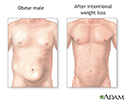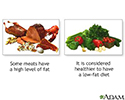Healthy habits for weight loss
Obesity - healthy habits; Obesity - healthy eating
Whether it is healthy or unhealthy, a habit is something you do without having to think about it. People who succeed at weight loss, turn healthy eating into a habit.
These healthy eating habits can help you lose weight and keep it off.
Set up Your Kitchen
The family kitchen can trigger unhealthy eating habits if your shelves are lined with sugary snacks. Rearrange the kitchen to make diet-boosting foods the most natural choice.
- Keep healthy food in sight. Keep a bowl of fruit on the counter and pre-chopped vegetables in the refrigerator. When you feel hungry, you'll have a healthy snack close at hand.
- Reduce temptation. If you know you can't control yourself around cookies, keep them and other diet-busting foods out of reach, or even better, out of the house.
- Always eat off dishes. Eating straight out of a container or a bag promotes overeating.
- Use smaller plates. If you start a meal with less food in front of you, you will likely eat less by the time it is over.
Practice Healthy Eating
Life gets busy and a lot of people end up eating without thinking about the food they're putting in their mouths. The following habits can help you avoid this mindless eating.
- Eat breakfast. An empty stomach is an invitation to overeat. Start your day with whole-grain bread or cereal, low-fat milk or yogurt, and a piece of fruit.
- Plan ahead. DO NOT wait until you are hungry to decide what to eat. Plan your meals and go shopping when you feel full. Unhealthy options will be easier to pass by.
- Power down your screen. Eating with your eyes on the TV, computer, or any other distracting screen takes your mind off what you're eating. Not only do you miss out on tasting your food, you are more likely to overeat.
- Eat healthy food first. Start with soup or salad and you'll be less hungry when you turn to the main course. Just steer clear of cream-based soups and salad dressings.
-
Eat small snacks often.
Rather than 2 or 3 large meals, you can eat smaller meals and
healthy snacks
to keep yourself going throughout the day.
Healthy snacks
Nibbles; Appetizers; Healthy eating - healthy snacks; Weight loss - healthy snacks; Healthy diet - healthy snacks; Wellness - healthy snacks
Read Article Now Book Mark Article - Weigh yourself. The information on the scale will help you see how your weight goes up or down depending on how you eat.
- Keep your house cool. Feeling slightly chilly in winter may help you burn more calories than if you keep your home on the warmer side.
Break old Habits
Emotional eating, or eating for comfort rather than nutrition, can make a big difference in what and how much you eat. To improve your relationship with food:
- Pay attention. Listen to your body for how certain foods make you feel. Fried food might taste great now. But how will it feel in your stomach an hour from now?
- Slow down. Put down your fork between bites or have a conversation as you eat. By pacing yourself, you give your stomach a chance to feel full.
- Keep track. Read the nutrition labels on your food before you eat it. Write down what you plan to eat before you eat. Both of these habits make you stop and think before you put something in your mouth.
- Change how you talk about food. Instead of saying "I can't eat that," say, "I don't eat that." Saying you can't may make you feel deprived. Saying you don't puts you in charge.
Get Support
Friends and family can help you stay on track and encourage you along the way. Be sure to pick people who understand how important this is and who will support you; not judge you or try to tempt you with old eating habits.
- Send progress reports. Tell your friends your goal weight and send them weekly updates of how you are doing.
- Use social media. Some mobile apps let you log everything you eat and share that with select friends. This can help you record and be accountable for what you eat.
References
Jensen MD. Obesity. In: Goldman L, Schafer AI, eds. Goldman's Cecil Medicine . 25th ed. Philadelphia, PA: Elsevier Saunders; 2016:chap 220.
Kelley CP, Sbrocco G, Sbrocco T. Behavioral modification for the management of obesity. Prim Care . 2016;43(1):159-175. PMID: 26896208 www.ncbi.nlm.nih.gov/pubmed/26896208 .
Moyer VA, US Preventive Services Task Force. Screening for and management of obesity in adults: US Preventive Services Task Force recommendation statement. Ann Intern Med . 2012;157(5):373-378. PMID: 22733087 www.ncbi.nlm.nih.gov/pubmed/22733087 .
Patrick VM, Hagtvedt H. "I Don't" versus "I Can't": When Empowered Refusal Motivates Goal-Directed Behavior. Journal of Consumer Research . 2012;39(2):371-381.
US Department of Health and Human Services and US Department of Agriculture. 2015 - 2020 Dietary Guidelines for Americans. 8th Edition. Updated December 2015. health.gov/dietaryguidelines/2015/guidelines . Accessed June 27, 2016.
US Department of Health and Human Services. Nutrition and weight status. Updated June 27, 2016. HealthyPeople.gov. www.healthypeople.gov/2020/topics-objectives/topic/nutrition-and-weight-status . Accessed June 27, 2016.
-
Weight loss - illustration
Losing excess weight by eating a healthy diet is one of the best ways of helping to prevent disease. Obesity increases the risk of illness and death due to diabetes, stroke, coronary artery disease, and kidney and gallbladder disorders. The more overweight, the higher the risk becomes.
Weight loss
illustration
-
Healthy diet - illustration
Fat is essential for the proper functioning of the body. However, adults should be aware of the fat content of food, and limit intake of saturated fats.
Healthy diet
illustration
-
Weight loss - illustration
Losing excess weight by eating a healthy diet is one of the best ways of helping to prevent disease. Obesity increases the risk of illness and death due to diabetes, stroke, coronary artery disease, and kidney and gallbladder disorders. The more overweight, the higher the risk becomes.
Weight loss
illustration
-
Healthy diet - illustration
Fat is essential for the proper functioning of the body. However, adults should be aware of the fat content of food, and limit intake of saturated fats.
Healthy diet
illustration
-
Weight control and diet
(In-Depth)
-
Obesity
(Alt. Medicine)
-
Heart-healthy diet
(In-Depth)
-
Eating disorders
(In-Depth)
-
Anorexia nervosa
(Alt. Medicine)
-
Exercise
(In-Depth)
-
Hypercholesterolemia
(Alt. Medicine)
-
Atherosclerosis
(Alt. Medicine)
-
Diabetes
(Alt. Medicine)
-
Cholesterol
(In-Depth)
Review Date: 5/21/2016
Reviewed By: Linda J. Vorvick, MD, Medical Director and Director of Didactic Curriculum, MEDEX Northwest Division of Physician Assistant Studies, Department of Family Medicine, UW Medicine, School of Medicine, University of Washington, Seattle, WA. Also reviewed by David Zieve, MD, MHA, Isla Ogilvie, PhD, and the A.D.A.M. Editorial team.


